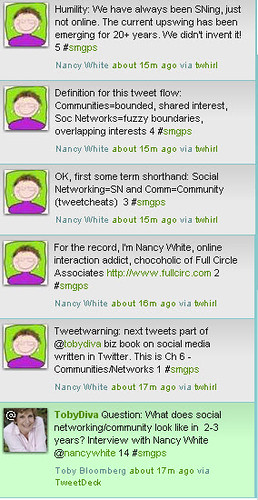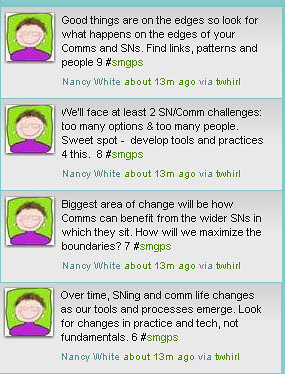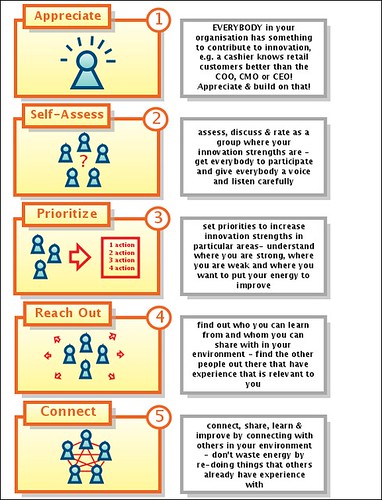OK, attack of the proud mamma. My son and his friend created an instructable for a cool money clip they make out of spoons. The spoon money clip. To keep this relevant to the blog, you have to love sites/networks like Instructables. Know how to do something? ‘Splain and share. One idea stimulates another, creating a network of reciprocating acts. Many of the Instructable projects reuse and recycle materials. Take a look:
Category: collaboration
Social Media Marketing GSP: A Tweet-book
 Toby Bloomberg is not the type to let the dust gather. She is always looking at things, asking “what can we do with that” and, rather than just asking, she starts trying and doing. She is a force to be reckoned with!
Toby Bloomberg is not the type to let the dust gather. She is always looking at things, asking “what can we do with that” and, rather than just asking, she starts trying and doing. She is a force to be reckoned with!
She is at it again with her latest experiment, Social Media Marketing GSP: A Tweet-book. She asked me to be one of her guinea pigs… um… I mean interviewees… for chapter 6 on communities and networks. Of course, I had to say yes. Here is a bit of context. My tweets are embedded. Let’s see if this makes any sense!
So what’s a Twitter-book you may be asking? It’s a book written using Twitter as platform and distribution channel. Social Media Marketing GPS #smgps is the first business book to experiment with this format.
This Twitter-book is structured as a “real” business book and includes: a foreword, introduction and chapters. Each chapter will have a 1 question interview with people knowledgeable about the topic. All posts will be hash-tagged #smgps.
Chapters and interviews will be tweeted Monday – Friday through the end of April. I invite you to join me in this experiment in a new way to write a business book. Please add your insights and learnings to the stream; they’ll be incorporated into the book. My ultimate goal is that this Twitter-book will serve as a resource about social media written by and for marketers. So explore .. have fun .. discover and don’t be afraid to try it out.
 Now that Toby is on chapter six, she has sussed out the process a bit and suggested earlier in the week that preparation is worth it, and that trying to not get carried away with too many tweets is also useful. That asks the writer to be both succinct per post (140 characters) and overall. With the size of the question Toby asked me, that was challenging. How to be brief but substantive, eh? It is harder than it looks.
Now that Toby is on chapter six, she has sussed out the process a bit and suggested earlier in the week that preparation is worth it, and that trying to not get carried away with too many tweets is also useful. That asks the writer to be both succinct per post (140 characters) and overall. With the size of the question Toby asked me, that was challenging. How to be brief but substantive, eh? It is harder than it looks.
It is also interesting to try and express something that both works read forwards and backwards. Readers reading back on Twitter, get it from tail to head. Those reading the recap on the blog and eventually the “book” (whatever form that might take) get it in order. Tricky. Interesting.
As I tweeted out my 12 140 character or less contributions, a few people wondered if I a) should be writing a blog post instead (they missed the context and Toby’s intro, I suppose) b) had too much nervous energy and c) how they might contribute. I think the burst of volume might not have been appreciated by all those people following me.
Hmmmm… what do you think?  Are we pushing a medium too far or is this a useful, creative application? Or something all together different?
Are we pushing a medium too far or is this a useful, creative application? Or something all together different?
Here are a few other creative writing experiments with Twitter:
- http://www.140characters.com/
- TwitterPoems (apropos for National Poetry month)
- Twitter Magnets
The interview for Chapter 6 is also now up here.
The cultures of collaboration – Inside Knowledge
 Shawn Callahan, Mark Schenk and I wrote a three part series for Inside Knowledge, the print magazine (yeah, I know. So yesterday!) I didn’t think any of it would show up freely available online, but lo and behold, part 2 is currently up. Take a gander… Masterclass: The cultures of collaboration – Inside Knowledge
Shawn Callahan, Mark Schenk and I wrote a three part series for Inside Knowledge, the print magazine (yeah, I know. So yesterday!) I didn’t think any of it would show up freely available online, but lo and behold, part 2 is currently up. Take a gander… Masterclass: The cultures of collaboration – Inside Knowledge
Masterclass: The cultures of collaboration
In part one of this series we set our definition for collaboration and introduced the idea of team, community and network collaboration. As we move between each of these different types of working together, how do our traditional notions of collaboration and collaborative culture vary?
In Part 2 we’ll begin to explore this question in our journey to build better collaborative workplaces. While we do, it is important to keep in mind that collaboration happens both within and among organisations. Tapping the wider networks outside, collaborating across organisations is an essential part of the collaboration landscape. But for the purpose of this article, we are taking the perspective of at least starting within.
Update: All three parts are available online. The Culture of Collaboration, Shawn Callahan, Nancy White and Mark Schenk, Inside Knowledge, 2008 (3 parts, part 1 here, part 2 available here, part 3 here.)
Technology Stewardship and Unexpected Uses
 I was cruising through my blog reader, hopelessly “behind” in reading (my own construction – I know I can “mark all read!”) and came upon a post from Vic Desotelle who pointed to a TED talk on Compassion which somehow lead me to a Garr Reynolds post about a TED Talk by Evan Williams of Twitter. (Talk about the network!)
I was cruising through my blog reader, hopelessly “behind” in reading (my own construction – I know I can “mark all read!”) and came upon a post from Vic Desotelle who pointed to a TED talk on Compassion which somehow lead me to a Garr Reynolds post about a TED Talk by Evan Williams of Twitter. (Talk about the network!)
The post had a quote that resonated with my experience as a technology steward to various communities.
Presentation Zen: TED talk: Twitter & the power of the unexpected
You never know how users will end up using your technology. Sometimes they end up using your product in creative ways that you could not possibly have thought of on your own.
As I work with NGOs attempting to roll out intranets and collaboration tools, I preach two things:
- technology is designed for groups, but experienced by individual
- users are creative – use that as a powerful positive force rather than trying to get them to conform with rules and limitations.
These two tenets have significance for technology stewards. It means that they cannot assume that the members of their community will have the same experience they do with any particular tool or platform, and that over time, the community will continue on a predictable trajectory of use of that technology.
It is about a dynamic evolution of practices and applications of the technology, not about the installation or the simple availability of the tool. So here are some practice hints.
- Role model your experience and practices with tools, but don’t present them as the only options.
- Watch for experimentation and amplify new, useful practices. Better yet, encourage community members to talk about and share their practices.
- When members ask for tool adjustments based on their experimentation, work hard to accommodate rather than block innovation. This may mean going to bat with “higher-ups” to gain permission, or to allow the experimentation to fly “under the radar” until you can make a case for the value of the changes.
- Encourage the fringies – the people who push the limits of a tool. Make them allies rather than enemies. Their pushing of your buttons may also create the innovation that you need to foster wider adoption.
What are your suggestions for technology stewardship that involved unexpected uses?
And… you never know where a link will lead you either. 😉
Photo credit: Alex Osterwalder on Flickr
Monday Video: Share
Crowdsourcing? Collaboration? See what you think as you watch Share